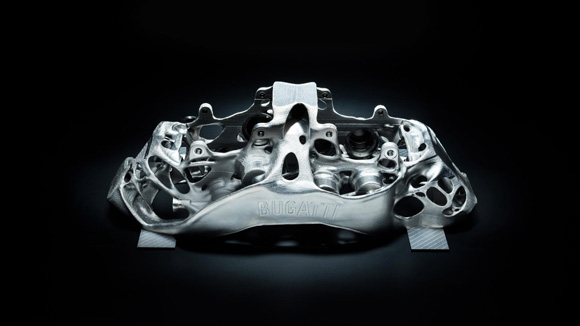Bugatti to trial additively manufactured titanium brake calipers
January 25, 2018

By using Selective Laser Melting, Bugatti and Laser Zentrum Nord report that they have been able to produce a complex structure which is significantly stiffer and stronger than would be possible with any conventional process (Courtesy Bugatti)
Bugatti Automobiles S.A.S. has successfully designed a titanium brake caliper that can be produced by metal Additive Manufacturing. Developed in partnership with German-based Laser Zentrum Nord GmbH, the brake calipers are said to be the largest in the automotive industry. The company expects to begin vehicle trials in the first half of 2018.
“Vehicle development is a never-ending process. This is particularly true at Bugatti,” says Frank Götzke, Head of New Technologies in the Technical Development Department of Bugatti Automobiles S.A.S. “In our continuing development efforts, we are always considering how new materials and processes can be used to make our current model even better and how future vehicles of our brand could be designed.”
Made in Ti6Al4V, a titanium alloy primarily used in the aerospace industry for highly stressed components, the new AM caliper is 41 cm long, 21 cm wide and 13.6 cm high, weighing just 2.9 kg. In comparison, similar aluminium components currently used by Bugatti weigh 4.9 kg – around 40% more.
It was a very moving moment for the team when we held our first titanium brake caliper from the 3D printer in our hands…” states Frank Götzke.
Bugatti is already said to use the most powerful brakes in the world for its new Chiron supercar. The brake calipers for that vehicle were forged from a block of high-strength aluminium alloy and incorporate eight titanium pistons on each of the front calipers and six on each of the rear units. These are currently the largest brake calipers installed on a production vehicle.
Ti6Al4V offers considerably higher performance than aluminium, with the alloy having a tensile strength of 1,250 N/mm2 in its additively manufactured form. According to Bugatti, this means that a force of slightly more than 125 kg would have to be applied to a square millimetre of the alloy to cause a rupture. While this extreme strength is an advantage for vehicle component production, it makes it unfeasible to produce geometrically complex titanium components such as the Chiron’s brake calipers using conventional manufacturing processes such as milling or forging.
By using Selective Laser Melting, Bugatti and Laser Zentrum Nord report that they have been able to produce a complex structure which is significantly stiffer and stronger than would be possible with any conventional process. According to Bugatti, the final, geometrically complex component incorporates walls with thicknesses between a minimum 1 mm and maximum 4 mm.

“Vehicle development is a never-ending process. This is particularly true at Bugatti.” – Frank Götzke, Head of New Technologies in Bugatti’s Technical Development Department (Courtesy Bugatti)
“It was a very moving moment for the team when we held our first titanium brake caliper from the 3D printer in our hands,” stated Götzke. “Everyone who looks at the part is surprised at how light it is – despite its large size. Technically, this is an extremely impressive brake caliper, and it also looks great.”
According to Bugatti, the development time for the new calipers was very short, spanning around three months from concept to finished component. Initially, the basic concept, strength and stiffness simulations, calculations and design drawings were sent to Laser Zentrum Nord as a complete data package. The institute then carried out process simulation and support structure design, followed by the first Additive Manufacturing of the component. According to Laser Zentrum Nord, the component was manufactured in 2,213 layers over a total build time of forty-five hours on a system equipped with four 400 W lasers.
The additively manufactured component was heat treated in order to eliminate residual stress and ensure dimensional stability, and its surface smoothed in a combined mechanical, physical and chemical process to further improve its fatigue strength. In the final manufacturing step, the contours of the component’s functional surfaces, such as its piston contact surfaces and threads, were machined in a five-axis milling machine in an operation spanning a further eleven hours.
The final, geometrically complex component incorporates walls with thicknesses between a minimum 1 mm and maximum 4 mm.”
“We were thrilled to be contacted by Bugatti. I do not know any other carmaker which makes such extreme demands of its products. We were pleased to face up to this challenge.” stated Prof. Dr.-Ing. Claus Emmelmann, formerly Managing Director of Laser Zentrum Nord GmbH and now Head of the Fraunhofer Institute for Additive Production Technologies (Fraunhofer IAPT) since Laser Zentrum Nord was incorporated in the Fraunhofer research organisation.
The first trials of the brake calipers for use in production vehicles are due to take place in the first half of 2018. Following successful trials, Bugatti stated that it expects to be able to considerably shorten production times, especially for machining, with a view to enabling series production.
In addition to trialing the calipers, Götzke and his team are also presenting the results of their work to Bugatti’s parent company Volkswagen Group and its brands. “In 3D printing development, Bugatti is the leader in the Volkswagen Group,” stated Götzke. “Everyone can and should benefit from our projects. This is also part of Bugatti’s role as the Group laboratory for high-tech applications.”
















